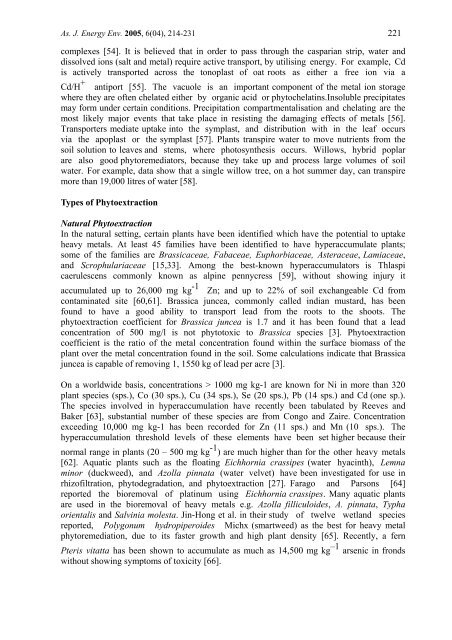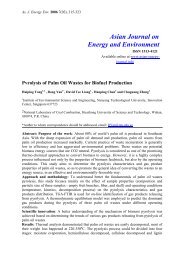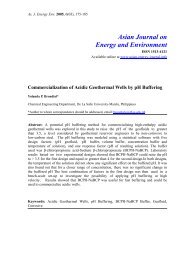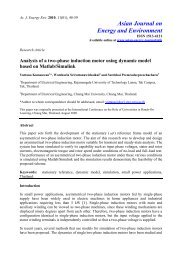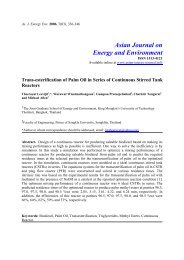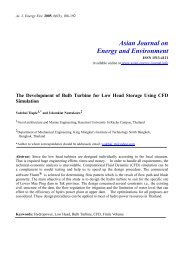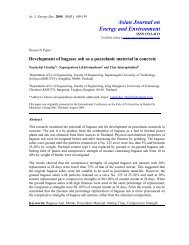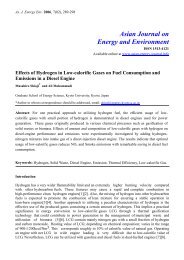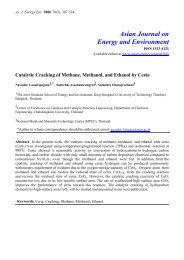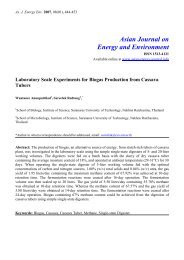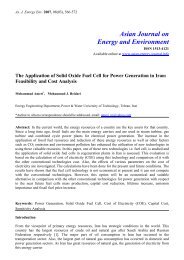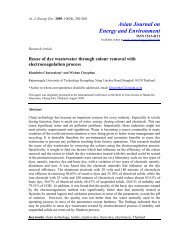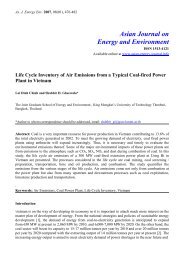As. J. Energy Env. 2005, 6(04), 214-231 221complexes [54]. It is believed that in order to pass through the casparian strip, water <strong>and</strong>dissolved i<strong>on</strong>s (salt <strong>and</strong> metal) require active transport, by utilising energy. For example, Cdis actively transported across the t<strong>on</strong>oplast <strong>of</strong> oat roots as e<strong>it</strong>her a free i<strong>on</strong> via aCd/H + antiport [55]. The vacuole is an important comp<strong>on</strong>ent <strong>of</strong> the metal i<strong>on</strong> storagewhere they are <strong>of</strong>ten chelated e<strong>it</strong>her by organic acid or phytochelatins.Insoluble precip<strong>it</strong>atesmay form under certain c<strong>on</strong>d<strong>it</strong>i<strong>on</strong>s. Precip<strong>it</strong>ati<strong>on</strong> compartmentalisati<strong>on</strong> <strong>and</strong> chelating are themost likely major events that take place in resisting the damaging effects <strong>of</strong> <strong>metals</strong> [56].Transporters mediate uptake into the symplast, <strong>and</strong> distributi<strong>on</strong> w<strong>it</strong>h in the leaf occursvia the apoplast or the symplast [57]. Plants transpire water to move nutrients from thesoil soluti<strong>on</strong> to leaves <strong>and</strong> stems, where photosynthesis occurs. Willows, hybrid poplarare also good phytoremediators, because they take up <strong>and</strong> process large volumes <strong>of</strong> soilwater. For example, data show that a single willow tree, <strong>on</strong> a hot summer day, can transpiremore than 19,000 l<strong>it</strong>res <strong>of</strong> water [58].Types <strong>of</strong> Phytoextracti<strong>on</strong>Natural Phytoextracti<strong>on</strong>In the natural setting, certain plants have been identified which have the potential to uptake<strong>heavy</strong> <strong>metals</strong>. At least 45 families have been identified to have hyperaccumulate plants;some <strong>of</strong> the families are Brassicaceae, Fabaceae, Euphorbiaceae, Asteraceae, Lamiaceae,<strong>and</strong> Scrophulariaceae [15,33]. Am<strong>on</strong>g the best-known hyperaccumulators is Thlaspicaerulescens comm<strong>on</strong>ly known as alpine pennycress [59], w<strong>it</strong>hout showing injury <strong>it</strong>accumulated up to 26,000 mg kg -1 Zn; <strong>and</strong> up to 22% <strong>of</strong> soil exchangeable Cd fromc<strong>on</strong>taminated s<strong>it</strong>e [60,61]. Brassica juncea, comm<strong>on</strong>ly called indian mustard, has beenfound to have a good abil<strong>it</strong>y to transport lead from the roots to the shoots. Thephytoextracti<strong>on</strong> coefficient for Brassica juncea is 1.7 <strong>and</strong> <strong>it</strong> has been found that a leadc<strong>on</strong>centrati<strong>on</strong> <strong>of</strong> 500 mg/l is not phytotoxic to Brassica species [3]. Phytoextracti<strong>on</strong>coefficient is the ratio <strong>of</strong> the metal c<strong>on</strong>centrati<strong>on</strong> found w<strong>it</strong>hin the surface biomass <strong>of</strong> theplant over the metal c<strong>on</strong>centrati<strong>on</strong> found in the soil. Some calculati<strong>on</strong>s indicate that Brassicajuncea is capable <strong>of</strong> removing 1, 1550 kg <strong>of</strong> lead per acre [3].On a worldwide basis, c<strong>on</strong>centrati<strong>on</strong>s > 1000 mg kg-1 are known for Ni in more than 320plant species (sps.), Co (30 sps.), Cu (34 sps.), Se (20 sps.), Pb (14 sps.) <strong>and</strong> Cd (<strong>on</strong>e sp.).The species involved in hyperaccumulati<strong>on</strong> have recently been tabulated by Reeves <strong>and</strong>Baker [63], substantial number <strong>of</strong> these species are from C<strong>on</strong>go <strong>and</strong> Zaire. C<strong>on</strong>centrati<strong>on</strong>exceeding 10,000 mg kg-1 has been recorded for Zn (11 sps.) <strong>and</strong> Mn (10 sps.). Thehyperaccumulati<strong>on</strong> threshold levels <strong>of</strong> these elements have been set higher because theirnormal range in plants (20 – 500 mg kg -1 ) are much higher than for the other <strong>heavy</strong> <strong>metals</strong>[62]. Aquatic plants such as the floating Eichhornia crassipes (water hyacinth), Lemnaminor (duckweed), <strong>and</strong> Azolla pinnata (water velvet) have been investigated for use inrhiz<strong>of</strong>iltrati<strong>on</strong>, phytodegradati<strong>on</strong>, <strong>and</strong> phytoextracti<strong>on</strong> [27]. Farago <strong>and</strong> Pars<strong>on</strong>s [64]reported the bioremoval <strong>of</strong> platinum using Eichhornia crassipes. Many aquatic plantsare used in the bioremoval <strong>of</strong> <strong>heavy</strong> <strong>metals</strong> e.g. Azolla filliculoides, A. pinnata, Typhaorientalis <strong>and</strong> Salvinia molesta. Jin-H<strong>on</strong>g et al. in their study <strong>of</strong> twelve wetl<strong>and</strong> speciesreported, Polyg<strong>on</strong>um hydropiperoides Michx (smartweed) as the best for <strong>heavy</strong> metalphytoremediati<strong>on</strong>, due to <strong>it</strong>s faster growth <strong>and</strong> high plant dens<strong>it</strong>y [65]. Recently, a fernPteris v<strong>it</strong>atta has been shown to accumulate as much as 14,500 mg kg –1 arsenic in fr<strong>on</strong>dsw<strong>it</strong>hout showing symptoms <strong>of</strong> toxic<strong>it</strong>y [66].
As. J. Energy Env. 2005, 6(04), 214-231 222Induced Phytoextracti<strong>on</strong> or Chelate assisted Phytoextracti<strong>on</strong>W<strong>it</strong>hin the plant cell <strong>heavy</strong> metal may trigger the producti<strong>on</strong> <strong>of</strong> oligopeptide lig<strong>and</strong>s knownas phytochelatins (PCs) <strong>and</strong> metallothi<strong>on</strong>eins (MTs) [67]. These peptides bind <strong>and</strong> formstable complex w<strong>it</strong>h the <strong>heavy</strong> metal <strong>and</strong> thus neutralise the toxic<strong>it</strong>y <strong>of</strong> the metal i<strong>on</strong> [68].Phytochelatin (PCs) is synthesised w<strong>it</strong>h glutathi<strong>on</strong>e as building blocks resulting in a peptidew<strong>it</strong>h structure Gly-(y-Glu-Cys-)n; {where, n = 2-11}. Appearance <strong>of</strong> phytochelating lig<strong>and</strong>shas been reported in hundreds <strong>of</strong> plant species exposed to <strong>heavy</strong> <strong>metals</strong> [69].Metallothi<strong>on</strong>eins (MTs), are small gene encoded, Cys-rich polypeptides. PCs are functi<strong>on</strong>allyequivalent to MTs [68].Chelators have been isolated from plants that are str<strong>on</strong>gly involved in the uptake <strong>of</strong> <strong>heavy</strong><strong>metals</strong> <strong>and</strong> their detoxificati<strong>on</strong>. Chelating agents like ethylenediamine tetra acetic acid(EDTA) are applied to Pb c<strong>on</strong>taminated soils that increases the amount <strong>of</strong>bioavailable lead in the soil <strong>and</strong> a greater accumulati<strong>on</strong> in plants is observed [70]. Theadd<strong>it</strong>i<strong>on</strong> <strong>of</strong> chelates to a lead c<strong>on</strong>taminated soil (total soil Pb 2500 mg kg–1) increasedshoot lead c<strong>on</strong>centrati<strong>on</strong> <strong>of</strong> Zea mays (corn) <strong>and</strong> Pisun sativum (pea) from less than 500 mgkg-1 to more than 10,000 mg kg –1 . This was achieved by adding synthetic chelate EDTAto the soil, similar results using c<strong>it</strong>ric acid to enhance uranium uptake have beendocumented. These results indicate that chelates enhanced or facil<strong>it</strong>ated Pb transport intothe xylem, <strong>and</strong> increased lead translocati<strong>on</strong> from roots to shoots. For the chelates tested,the order <strong>of</strong> effectiveness in increasing Pb desorpti<strong>on</strong> from the soil was EDTA >Hydroxyethylethylene-diaminetriacetic acid (HEDTA) > Diethylenetriaminepentaaceticacid (DTPA) > Ethylenediamine di(o-hyroxyphenylacetic acid) EDDHA [70].Vassil et al., [71] reported that Brassica juncea exposed to Pb <strong>and</strong> EDTA in hydrop<strong>on</strong>icsoluti<strong>on</strong> was able to accumulate up to 55 mM kg -1 Pb in dry shoot tissue (1.1% [w/w]).This represents a 75-fold c<strong>on</strong>centrati<strong>on</strong> <strong>of</strong> lead in shoot over that in soluti<strong>on</strong>. Athreshold c<strong>on</strong>c. <strong>of</strong> EDTA (0.25 mM) was required to stimulate this dramaticaccumulati<strong>on</strong> <strong>of</strong> both lead <strong>and</strong> EDTA in shoots.Genetic Engineering to improve phytoremediati<strong>on</strong>To breed plants having superior phytoremediati<strong>on</strong> potential w<strong>it</strong>h high biomassproducti<strong>on</strong> can be an alternative to improve phytoremediati<strong>on</strong>. General plantproductiv<strong>it</strong>y is c<strong>on</strong>trolled by many genes <strong>and</strong> difficult to promote by single geneinserti<strong>on</strong>. Genetic engineering techniques to implant more efficient accumulator gene intoother plants have been suggested by many authors [29,60,72]. Implanting more efficientaccumulator genes into other plants that are taller than natural plants increases the finalbiomass. Zhu et al. [73] genetically engineered Brassica juncea to investigate rate-lim<strong>it</strong>ingfactors for glutathi<strong>on</strong>e <strong>and</strong> phytochelatin producti<strong>on</strong>; they introduced the Escherichia coli-gshl- gene. The y-ECS transgenic seedlings showed increased tolerance to cadmium<strong>and</strong> had higher c<strong>on</strong>centrati<strong>on</strong>s <strong>of</strong> Phytochelatins, y-GluCys, glutathi<strong>on</strong>e, <strong>and</strong> totaln<strong>on</strong>protein thiols compared to wild type seedlings. The potential <strong>of</strong> success <strong>of</strong> geneticengineering can be lim<strong>it</strong>ed because <strong>of</strong> anatomical c<strong>on</strong>straints [74].Lim<strong>it</strong>ati<strong>on</strong>s <strong>of</strong> Phytoextracti<strong>on</strong>Phytoextracti<strong>on</strong> <strong>and</strong> plant-assisted bioremediati<strong>on</strong> is most effective if soil c<strong>on</strong>taminati<strong>on</strong> islim<strong>it</strong>ed to w<strong>it</strong>hin 3 feet <strong>of</strong> the surface, <strong>and</strong> if groundwater is w<strong>it</strong>hin 10 feet <strong>of</strong> the surface[16, 18]. It is applicable to s<strong>it</strong>es w<strong>it</strong>h low to moderate soil c<strong>on</strong>taminati<strong>on</strong> over largeareas, <strong>and</strong> to s<strong>it</strong>es w<strong>it</strong>h large volumes <strong>of</strong> groundwater w<strong>it</strong>h low levels <strong>of</strong> c<strong>on</strong>taminati<strong>on</strong> thathave to be cleaned to low (strict) st<strong>and</strong>ards [26]. This necess<strong>it</strong>ates soil fertilizati<strong>on</strong>,c<strong>on</strong>d<strong>it</strong>i<strong>on</strong>ing,importance <strong>of</strong> employing effective agr<strong>on</strong>omic practices [70, 72]. Scientists haveinvestigated the effect <strong>of</strong> soil acidificati<strong>on</strong> <strong>on</strong> Zn <strong>and</strong> Cd phytoextracti<strong>on</strong> <strong>and</strong> proposed the
- Page 3 and 4: As. J. Energy Env. 2005, 6(04), 214
- Page 5 and 6: As. J. Energy Env. 2005, 6(04), 214
- Page 7: As. J. Energy Env. 2005, 6(04), 214
- Page 11 and 12: As. J. Energy Env. 2005, 6(04), 214
- Page 13 and 14: As. J. Energy Env. 2005, 6(04), 214
- Page 15 and 16: As. J. Energy Env. 2005, 6(04), 214
- Page 17 and 18: As. J. Energy Env. 2005, 6(04), 214


